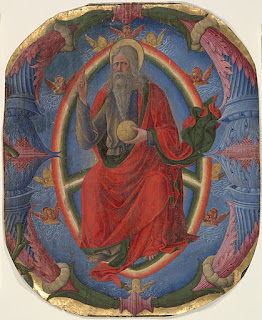There are a number of illuminated cuttings at the Yale Art Gallery whose 20th-century provenance seems to have been "lost" (or at least forgotten).
Most of them are described and reproduced in the catalogue of the exhibition of illuminations from the collection of Robert Lehman: Treasures of a Lost Art: Italian Manuscript Painting of the Middle Ages and Renaissance, edited by Pia Palladino (New York, 2003), nos. 48a-i, 57, 64, and Appendix, no. 1.
They fall into several distinct groups:
Cat. nos. 48a-b are two historiated initials, said to be from an Antiphonary, and attributed to Jacopo Filippo Medici d'Argenta, Ferrara, c.1490-1500
 |
| "King David in an Initial D" [Source of this and the next few images] |
 |
| "Angel Playing the Timbrel in an initial C" |
"hic requi/ em demo (or domo)/ vite mee", doubtless parts of Psalm 26 verse 4:
"hanc requiram ut inhabitem in domo Domini omnes dies vite mee".
Another of the standard major divisions of the Psalter is Psalm 97, which begins "Cantate domino canticum novum ..." and is normally illustrated with some form of music-making, such as monks chanting at a lectern; an angel with a timbrel would be perfectly appropriate. The text on the back of this cutting is transcribed as "eia omniv [m]/ . . . id demo/ quim [ur] ab": it is hard to make any sense of this, but I suspect that it is a partially-effaced passage from Psalm 96, 97, or 98, depending on whether the initial is on the recto or verso.
Cat. nos. 48c-i are seven foliate initials, a single one and a group of six, with the same attribution as nos. 48a-b above
 |
| [Source] |
The texts on the backs of these have not been photographed, and are not recorded in the catalogue, except that the back of no. 48f (the initial "S") has a rubric referring to first vespers of the Exaltation of the Cross (14 September), hence the suggestion that they are from an Antiphonary. But to judge by the vertical rulings in red ink visible in all six, this latter group is not from the same manuscript as the other one, or the two historiated ones, discussed above, which I suggest come from a Psalter.
Cat. no. 57 is a fine historiated initial depicting a saint-bishop, tentatively attributed to The Master of the Franciscan Breviary, Lombardy, c.1450-60:
No text is reported, but it is clearly from a choirbook, as red musical staves are visible.
Relegated to the Appendix of the catalogue, and with only a black and white reproduction, is this unsophisticated but rather charming initial depicting the Virgin and Child, attributed tentatively to the Lombard "Miniatore di Monza (?)", in the last quarter of the 13th century, and said to be from a Gradual:
 |
| [Source] |
Finally, the largest and most impressive initial (described as a "D" or "O") is Cat. no. 64, of which a detail is shown at the top of this page, and attributed to Girolamo da Cremona, c.1470-74:
 |
| [Source] |
"... donis beatis munere.Thus the initial is perhaps not an "O" or a "D", but a "P" with the left vertical cropped off.
Iam nunc paterna claritas te
postulamus affatim absit libido
sordidans omnisque actus noxius
Ne foeda sit vel lubrica compago
nostri corporis per quam averni ignibus
ipsi crememur acrius. Ob hoc
redemptor quesumus ut probra nostra diluas ..."
In each case, the earliest recorded provenance of the cuttings above, all of which were given to Yale by Robert Lehamn in 1954, is a variant of "Acquired in Paris, 1953", with a footnote explaining that the only evidence for this statement is that "The provenance is recorded by Seymour (1970) [i.e. Early Italian Paintings in the Yale Art Gallery: A Catalogue, 1970] ... [but] no records of the purchase have been found in the Robert Lehman Collection archives".
A combination of the subject-matter of the largest cutting, God the Father; the artist, Girolamo da Cremona; and the subjects of the other initials with which it shares a provenance, allow us to identify them all as coming from the important collection of André-Jean Hachette (1873-1952).
They were lot 56 in the auction catalogue: Collection André Hachette: manuscrits du XIIe au XVIe siècle, miniatures, imprimés des XVe et XVIe siècles, riches reliures armoriées, Librairie Giraud-Badin, Paris, 16 December 1953:
Although there is no reproduction in the published catalogue, there is a photo at the Courtauld Institute of the framed group:
This shows that in addition to five Italian cuttings, the ensemble included four Netherlandish/Germanic ones, also part of the same 1954 Lehman gift to Yale:
 |
| [Source] |
[1]
In the New York exhibition catalogue, Painting in Renaissance Siena, 1420-1500, ed. by K. Christiansen, L. B. Kanter, and C. B. Strehlke (Metropolitan Museum of Art, 1988), no. 53, the cutting is described as coming from a Psalter, with the comment that "The fragmentary passage on the reverse of the sheets is insufficient to indetify the text illustrated, although Psalm 92 (93) ... would be appropriate". The 2003 catalogue transcribes the text as: "donis b[ea]tis mu/ ac pat[i]na claritas/ affati ab sit libro/ a[...]is quem actus noxiu/ sit ul[...] lubrica [con]pa/ po[n]is p[er] qua[m] a[...]ni i/ acrius. Ob ho".
EDIT 23 August 2020
Giacomo Baroffio has been in contact to say that the Girolamo da Cremona cutting does not necessarily have to be from a hymnbook, but could be a psalter-hymnbook or a breviary; its dimensions suggest a hymnbook or a psalter-hymnbook.






No comments:
Post a Comment
** PLEASE INCLUDE YOUR NAME IN YOUR COMMENT **
I may ignore and delete anonymous comments